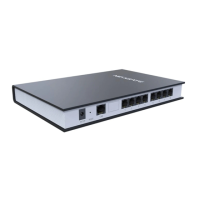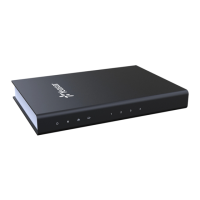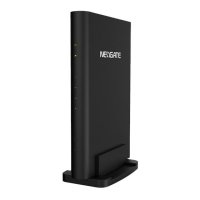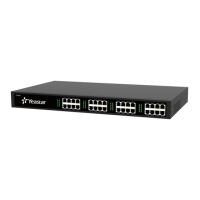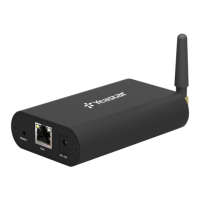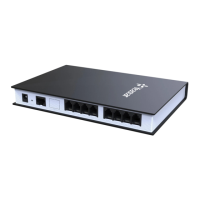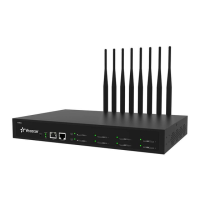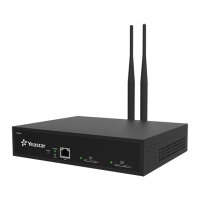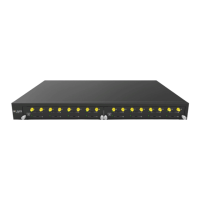Do you have a question about the Yeastar Technology TA1600 and is the answer not in the manual?
| Ports | 16 FXS ports |
|---|---|
| Protocols | SIP (RFC3261), IAX2 |
| Transport Protocols | UDP, TCP, TLS, SRTP |
| Operating Temperature | 0°C to 40°C |
| Humidity | 10% to 90% Non-condensing |
| Voice Codec | G.711, G.722, G.723, G.729 |
| Fax | T.38 |
| NAT Traversal | STUN |
| Management | SNMP |
| Storage Temperature | -20°C to 65°C |
| Power Supply | AC 100-240V, 50/60Hz, DC 12V, 1A |
Describes the intended reader of this manual.
Provides essential safety precautions related to electrical hazards.
Lists the key features and capabilities of the TA1600/2400/3200.
Instructions for accessing the device's web-based graphical user interface.
Overview of the main sections and functions within the web configuration panel.
Guides on how to initiate and answer calls using the device.
Details on using the voice menu for device configuration and network settings.
Procedure for placing an active call on hold and resuming it.
Explanation of how call waiting functionality works and how to manage incoming calls.
Steps for performing blind and attended call transfers.
Configuration options for the general settings of FXS ports.
Advanced configuration settings for FXS ports, including call forwarding and caller ID.
Setting up and configuring hunt groups for routing calls to multiple FXS ports.
Configuration of VoIP server templates and registration modes for SIP/IAX.
Defines how to route calls from FXS ports to VoIP servers or extensions.
Configuration options for the Session Initiation Protocol (SIP) trunk.
Configuring Network Address Translation (NAT) settings for SIP communication.
Quality of Service settings to prioritize voice traffic over other network data.
Customizing SIP response codes for better call status understanding by the VoIP server.
Settings to improve the reception and sending of T.38 FAX transmissions.
Various advanced SIP protocol configurations for fine-tuning performance and security.
Configuration for the Internal Asterisk Exchange (IAX) protocol for connecting to Asterisk servers.
Global configuration settings for the gateway, including music on hold and transfer options.
Lists and describes the default feature codes for various gateway functions.
Configuration and usage of the speed dial feature for quick dialing.
Instructions for uploading and managing custom voice prompts for the system.
Guide to uploading and managing music files for the 'music on hold' feature.
Information on downloading and managing system-provided voice prompts (Chinese/English).
Configuration of distinct ringtones based on incoming caller ID patterns.
Customizing audio tones for different countries and regions.
Configuration of RADIUS servers for authentication, authorization, and accounting (AAA).
Configuring the Local Area Network (LAN) interface, including IP addressing.
Configuration of the Wide Area Network (WAN) port for internet connectivity.
Managing access methods like SSH, FTP, HTTP, and HTTPS for the device.
Setting up Virtual Local Area Networks (VLANs) for network segmentation.
Configuring Virtual Private Network (VPN) connections for secure remote access.
Setting up Dynamic DNS services to access the device using hostnames.
Defining static routes for directing network traffic through specific gateways.
Configuring Simple Network Management Protocol (SNMP) for network device management.
Configuration for TR-069 protocol for remote device management by an ACS.
Guides on connecting the TA gateway to Yeastar Remote Management for centralized control.
Overview and configuration of the device's firewall settings.
Checking the status and configuring security-related services like SSH and HTTP.
Viewing and configuring network ports used by services like SIP and HTTP.
Configuring alerts for IP-based attacks, including phone and email notifications.
Setting up alerts for failed web login attempts to prevent unauthorized access.
Configuring Asterisk Manager Interface (AMI) for system monitoring and management.
Uploading CA certificates for TLS verification, necessary for secure communication.
Uploading server certificates for TLS transport security.
Basic firewall configurations, including enabling the firewall and ping blocking.
Creating and managing custom firewall rules for specific traffic and ports.
Configuring automatic defense rules to protect against network attacks based on traffic rates.
Managing IP addresses that are automatically blocked due to exceeding traffic limits.
Procedure for changing the system's administrator password for security.
Setting the system's date, time, and time zone for accurate logging and operations.
Configuring automatic provisioning methods (PNP, DHCP, Server URL) for device setup.
Instructions for upgrading the device firmware via HTTP or TFTP.
Creating backups of configuration data and restoring them.
Options for rebooting the system or resetting it to factory default settings.
Displaying the operational status of each FXS port, including up/down and hook status.
Monitoring the network status, including IP address, MAC address, and DNS settings.
Viewing hardware and firmware versions, uptime, and disk usage of the system.
Viewing and filtering detailed records of all calls made and received.
Accessing and managing system logs for troubleshooting and monitoring.
Using the packet capture tool to capture network packets for analysis.
Monitoring the activity of specific FXS ports for debugging purposes.
